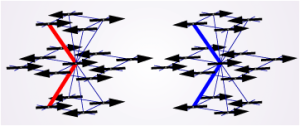Frustration
When two or more interaction terms are conflicting with each other in some physical system, we say that the system is frustrated. Most non-trivial behaviors originate in some sort of frustration whether it is a physical system or a more general manybody system. This is because in frustrated systems new degrees of freedom are often formed as a result of minimization of local conflict. For example, if we have three classical spins that tend to align antiparallel to each other, they naturally form the 120-degree structure in which any two spins form an angle of 120 degrees. Moreover, if we have multiple triangular lattices and corresponding spins on different lattices interact with each other, we observe even more complicated ordering such as incommensurate order and lattice-rotation symmetry breaking. (Ref. “First-Order Transition to Incommensurate Phase in Frustrated Heisenberg Model“) When a uniaxial spin anisotropy is introduced to the triangular-lattice spin system, various phases with different type of ordering appear. (Ref. “Monte Carlo Simulation of Triangular Antiferromagnets with Easy-axis Anisotropy“)
Dimension Reduction
Frustration also influences quantum critical phenomena in an interesting way. For example, in the bct lattice, in which square lattices stack on top of each other with 0.5 lattice spacing shift, interlayer effective interaction decrease as we approach the quantum critical point, leading to asymptotically two-dimensional behavior. (Ref. “Dimension Reduction in Quantum Critical Point of BCT Magnets“) The finite temperature phase transition of this system also has unusual character due to additional Z2 degrees of freedom. (Ref. “Finite-Temperature Transition in the Spin-Dimer Antiferromagnet BaCuSi2O6“)

Dipole System
All real magnetic systems have weak but finite dipole interaction and in some cases this is non-negligible. This interaction is important also in ferroelectricity. Monte Carlo simulation is powerful tool for studying slow dynamic behavior characteristic to this long range interaction. (Ref. “Monte Carlo Study of Two-Dimensional Heisenberg Dipolar Lattices“)
Spin Glass
Spin glass is a system with randomness in addition to frustration. While in regular frustrated systems the internal conflict dissapears in the first stage of renormalization as a result of forming new local degree of freedom, in spin glasses it persists in all scales. In other words, a spin glass system is a world where components are conflicting each other in all levels, that reminds us a real world, which is a true source of research motivation of this subject. It is therefore not surprizing that spin glass problems are extremely difficult: theoretically complete solution is almost impossible, numerical optimization is blocked by NP hardness (see below), and experiments never reach true equilibrium. Various apprximation methods are examined. (Ref. “Tree Approximation to Spin Glass Models“)
NP Hardness
It is difficult to find a ground state of complicated frustrated systems such as spin glasses by numerical computation (even more so by pen and paper). The problem of finding ground state of spin glasses in three dimensions is NP hard. This means that if we find a way to solve it in polynomial time the following statement becomes true: All decision problem for which a proposed solution can be checked in polynomial time can also be solved in polynomial time (even without proposed solutions). Since the statement sounds outrageous and is most likely false, most researchers believe that there is no polynomial time algorithm for 3D spin glasses.
Simulated Annealing
Nevertheless, in our lives we are surrounded by optimization problems, and we cannot stop trying to solve them. Simulated annealing is a very flexible approach to optimization that yields “not so bad” solutions in most cases though not the best. In this approach we introduce temperature to the problem even when the problem has no physical origin, and reduce the temperature gradually. Recently, not only thermal fluctuation but also quantum fluctuation is also studied for even further optimization.